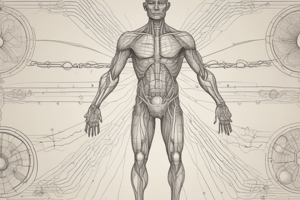Podcast
Questions and Answers
What is the primary purpose of homeostasis in the human body?
What is the primary purpose of homeostasis in the human body?
- To achieve rapid changes in the internal environment
- To regulate only the external environment
- To allow the body to adapt to any external changes without limits
- To maintain the internal environment in a steady and balanced state (correct)
Which of the following describes the external environment as mentioned in the context?
Which of the following describes the external environment as mentioned in the context?
- The blood within the body
- The interstitial fluid surrounding body cells
- The fluid inside body cells
- The surroundings outside of the body (correct)
What mechanism do homeostatic control systems mainly depend on to maintain a constant internal environment?
What mechanism do homeostatic control systems mainly depend on to maintain a constant internal environment?
- Random fluctuations
- Positive feedback
- Negative feedback (correct)
- Feedforward control
Which of these is NOT an example of a variable maintained by homeostasis in humans?
Which of these is NOT an example of a variable maintained by homeostasis in humans?
What is an example of the body's internal environment as described in the context?
What is an example of the body's internal environment as described in the context?
What typically happens when a body's variable fluctuates above or below the set point in homeostatic control systems?
What typically happens when a body's variable fluctuates above or below the set point in homeostatic control systems?
Flashcards are hidden until you start studying
Study Notes
Homeostasis
- Homeostasis is a steady state condition where the body's internal environment remains relatively constant within narrow physiological limits despite significant changes in the external environment.
- The internal environment refers to the immediate surroundings of the body cells, providing the medium in which they live, and includes examples such as interstitial fluid and blood.
- Homeostasis is essential for maintaining a steady and balanced internal environment and establishing optimum conditions for the human body.
Homeostatic Control Systems
- Homeostatic control systems in the human body rely on negative feedback mechanisms to maintain a constant level and prevent serious changes in the internal environment.
- Homeostasis is achieved by maintaining a variable (e.g., body temperature, blood glucose) at a set point.
- A fluctuation in the variable above or below the set point triggers a response to return the variable to the set point, maintaining homeostasis.
Studying That Suits You
Use AI to generate personalized quizzes and flashcards to suit your learning preferences.



